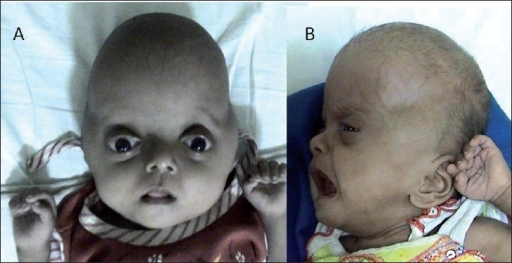
Back متلازمة فايفر Arabic Pfeifferov sindrom BS Pfeiffer-Syndrom German Σύνδρομο Pfeiffer Greek Síndrome de Pfeiffer Spanish Pfeifferin oireyhtymä Finnish Syndrome de Pfeiffer French Sindrom Pfeiffer ID Sindrome di Pfeiffer Italian Пфайффер синдромы Kazakh
| Pfeiffer syndrome | |
|---|---|
 | |
| Pfeiffer syndrome type 2 with cloverleaf-shaped skull and bilateral proptosis before and after surgery | |
| Specialty | Rheumatology |
| Causes | Genetic[1] |
| Frequency | 1 per 100,000 births[1] |
| Named after | Rudolf Arthur Pfeiffer |
Pfeiffer syndrome is a rare genetic disorder, characterized by the premature fusion of certain bones of the skull (craniosynostosis), which affects the shape of the head and face. The syndrome includes abnormalities of the hands and feet, such as wide and deviated thumbs and big toes.
Pfeiffer syndrome is caused by mutations in the fibroblast growth factor receptors FGFR1 and FGFR2. The syndrome is grouped into three types: type 1 (classic Pfeiffer syndrome) is milder and caused by mutations in either gene; types 2 and 3 are more severe, often leading to death in infancy, caused by mutations in FGFR2.[2]
There is no cure for the syndrome. Treatment is supportive and often involves surgery in the earliest years of life to correct skull deformities and respiratory function.[2] Most persons with Pfeiffer syndrome type 1 have a normal intelligence and life span; types 2 and 3 typically cause neurodevelopmental disorders and early death. Later in life, surgery can help in bone formation and facial construction.
Pfeiffer syndrome affects about 1 in 100,000 persons.[1] The syndrome is named after a German geneticist, Rudolf Arthur Pfeiffer (1931–2012), who described it in 1964.[3]
- ^ a b c Vogels A, Fryns JP (2006). "Pfeiffer syndrome". Orphanet J Rare Dis. 1: 19. doi:10.1186/1750-1172-1-19. PMC 1482682. PMID 16740155.
- ^ a b "Pfeiffer Syndrome". NORD (National Organization for Rare Disorders). Retrieved 2019-09-03.
- ^ Cite error: The named reference
pmid14316612was invoked but never defined (see the help page).
© MMXXIII Rich X Search. We shall prevail. All rights reserved. Rich X Search